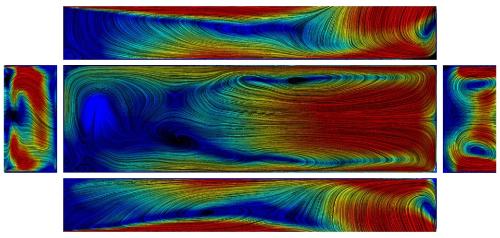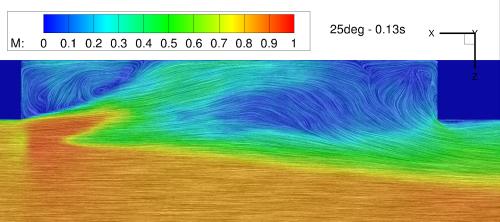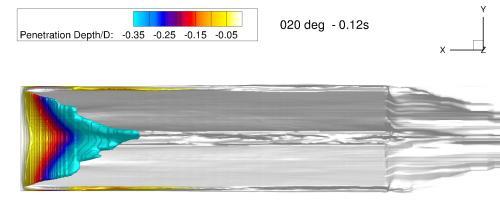Transonic Cavity Flow
The next-generation of uninhabited air vehicles carry stores in internal bays for stealth. This has a drawback that once the bays are exposed they act as resonant cavities producing substantial noise and vibration. This complex flow problem is usually studied using idealised configurations of flows inside rectangular cavities exposed to a stream of high speed flow. Strong interactions arise from the shear layer formed across the cavity and the acoustic waves radiated from the downstream cavity wall. This feedback mechanism can be seen using numerical schlieren that highlights the complexity of the flow-field inside the cavity. The computations are demanding since these require long time-histories of the flow to be captured for the flow statistics to be extracted. Computations of the idealised cavity typically require CFD grids of about 5 million cells but this size increases with the Reynolds number and the complexity of the flow geometry.
The current project uses turbulence simulation methods including Detached-Eddy Simulation and Scale-Adaptive Simulation to resolve this very turbulent, energetic flow field. The cost of turbulence simulation is high due to having to resolve a range of flow scales from small to large and short-lived to long-lived.
The study of cavity flow in weapon bay has two main objectives. First, to understand how the trajectories are affected by the unsteadiness. A large variability of the trajectories is seen that can lead in rare case to a return of a store toward the bay. Second, the stuctures are subject to large unsteady loads leading in some case to structure resonance and fatigue problems. HMB3 can perform multiphisic simulation coupling Computational Fluid Dynamics, aeroelasticity with a modal method and release trajectory with a Six Degrees of Freedom to assess the complex physics of weapon bay flow.
Publications
- Loupy, G.J.M. and Barakos, G.N. (2017) Assessment of store release variability from weapon bay using scale adaptive simulation. AIAA Journal, (doi:10.2514/1.J056485)
- Loupy, G.J.M., Barakos, G.N. and Kusyumov, A. (2017) Acoustic field around a transonic cavity flow. International Journal of Aeroacoustics, 16(6), pp. 507-535. (doi:10.1177/1475472X17730459)
- Loupy, G.J.M. and Barakos, G.N. (2017) Processing and analysis methods for transonic cavity flow. Physics of Fluids, 29(7), 076105. (doi:10.1063/1.4995461)
- Loupy, G.J.M., Barakos, G.N. and Taylor, N.J. (2017) Cavity flow over a transonic weapon bay during door operation. Journal of Aircraft, (doi:10.2514/1.C034344) (Early Online Publication)
- Loupy, G.J.M. and Barakos, G.N. (2017) Modelling of Transonic Shallow Cavity Flows, and Store Release Simulations from Weapon Bays. In: 2017 AIAA Aviation Forum, Denver, CO, USA, 05-09 Jun 2017, ISBN 9781624105012 (doi:10.2514/6.2017-3252)
- Babu, S.V., Loupy, G.J.M, Dejaeze, F., Barakos, G.N., and Taylor, N.J. (2016) Aeroelastic simulations of stores in weapon bays using Detached-Eddy simulation. Journal of Fluids and Structures, 99, pp. 207-228. (doi:10.1016/j.jfluidstructs.2016.07.014).
- Loupy, G. J.M. and Barakos, G. N. (2016) Multi-Disciplinary Analysis of Flow in Weapon Bays. 6th HRLM Symposium on Hybrid RANS-LES Methods, Strasbourg, France, 26-28 Sep 2016. (In Press)
- Loupy, G.J.M. and Barakos, G.N. (2016) Acoustic Field Around a Transonic Cavity Flow. Fourth International Workshop on Computational Experiments in Aeroacoustics, Svetlogorsk, Russia, 21-24 Sep 2016.
- Loupy, G.J.M., Barakos, G.N. and Taylor, N.J. (2016) Cavity Flow Over a Transonic Weapon Bay During Door Operation. RAS Applied Aerodynamics Conference, Bristol, UK, 19-21 Jul 2016.
- Babu, S. V., Zografakis, G., Barakos, G. N., and Kusyumov, A. (2016) Evaluation of scale-adaptive simulation for transonic cavity flows. International Journal of Engineering Systems Modelling and Simulation, 8(2), pp. 106-124. (doi:10.1504/IJESMS.2016.075510)
- Babu, S.V., Zografakis, G., and Barakos, G.N. (2015) Evaluation of scale-adaptive simulations for transonic cavity flows. In: Girimaji, S., Haase, W., Peng, S.-H. and Schwarmborn, D. (eds.) Progress in Hybrid RANS-LES Modelling. Series: Notes on numerical fluid mechanics and multidisciplinary design (130). Springer, pp. 433-444. ISBN 9783319151403 (doi:10.1007/978-3-319-15141-0_35)
- Babu, S.V., Dehaeze, F. and Barakos, G.N. (2014) Understanding Store Loads using DES and Strongly-Coupled Aeroelastic Simulations. In: 52nd Aerospace Sciences Meeting, AIAA SciTech Forum (SciTech2014), National Harbor, MD, USA, 13-17 Jan 2014, ISBN 9781624102561 (doi:10.2514/6.2014-1252)
- S.V. Babu and G.N. Barakos (2014), Prediction of Acoustics of Transonic Cavities using DES and SAS. 49th International Symposium of Applied Aerodynamics: Aerodynamics and Environment, Lille, France, 24-26 March, 2014.
- S.V. Babu and G.N. Barakos (2014), Store Release from Cavities using Overset Grids and Scale-Adaptive Simulations. the Royal Aeronautical Society Biennial Applied Aerodynamics Research Conference: Advanced Aero Concepts, Design and Operations, Bristol, UK, 22-24 July, 2014.
- Lawson, S. J., and Barakos, G. N. (2012) Influence of stores on the flow inside UCAV weapon bays. Aeronautical Journal, 116(1176), pp. 199-215.
- Lawson, S. J., and Barakos, G. N. (2011) Review of numerical simulations for high-speed, turbulent cavity flows. Progress in Aerospace Sciences, 47(3), pp. 186-216. (doi:10.1016/j.paerosci.2010.11.002)
- Lawson, S. J., and Barakos, G. N. (2010) Computational fluid dynamics analyses of flow over weapons-bay geometries. Journal of Aircraft, 47(5), pp. 1605-1623. (doi:10.2514/1.C000218)
- Lawson, S. J., and Barakos, G. N. (2010) Evaluation of DES for weapons bays in UCAVs. Aerospace Science and Technology, 14(6), pp. 397-414. (doi:10.1016/j.ast.2010.04.006)
- Lawson, S.J. and Barakos, G.N. (2010) Evaluation of DES for Weapons Bays in UCAVs. In: 48th AIAA Aerospace Sciences Meeting Including The New Horizons Forum and Aerospace Exposition, Orlando FL, USA, 4-7 Jan 2010, ISBN 9781600869594 (doi:10.2514/6.2010-1425)
- Lawson, S.J., and Barakos, G.N. (2010) DES for UCAV weapon bay flow. In: Peng, S.-H., Doerffer, P. and Haase, W. (eds.) Progress in Hybrid RANS-LES Modelling. Series: Notes on numerical fluid mechanics and multidisciplinary design (111). Springer, pp. 123-135. ISBN 9783642141676 (doi:10.1007/978-3-642-14168-3_10)
- Lawson, S., Barakos, G., and Simpson, A. (2010) Understanding cavity flows using proper orthogonal decomposition and signal processing. Journal of Algorithms and Computational Technology, 4(1), pp. 47-70. (doi:10.1260/1748-3018.4.1.47)
- Lawson, S.J., Barakos, G.N., and Nayyar, P. (2009) Annex 18A: Appendix for test case A2 - M219 cavity flow: computations with and without bay doors. In: Haase, W., Braza, M. and Revell, A. (eds.) DESider - A European Effort on Hybrid RANS-LES Modelling: Results of the European-Union Funded Project, 2004-2007. Series: Notes on numerical fluid mechanics and multidisciplinary design (103). Springer, pp. 286-291. ISBN 9783540927723
- Lawson, S. J., and Barakos, G. N. (2009) Assessment of passive flow control for transonic cavity flow using detached-eddy simulation. Journal of Aircraft, 46(3), pp. 1009-1029. (doi:10.2514/1.39894)
- Barakos, G. N., Lawson, S. J., Steijl, R., and Nayyar, P. (2001) Numerical simulations of high-speed turbulent cavity flows. Flow, Turbulence and Combustion, 83(4), pp. 569-585. (doi:10.1007/s10494-009-9207-1)






